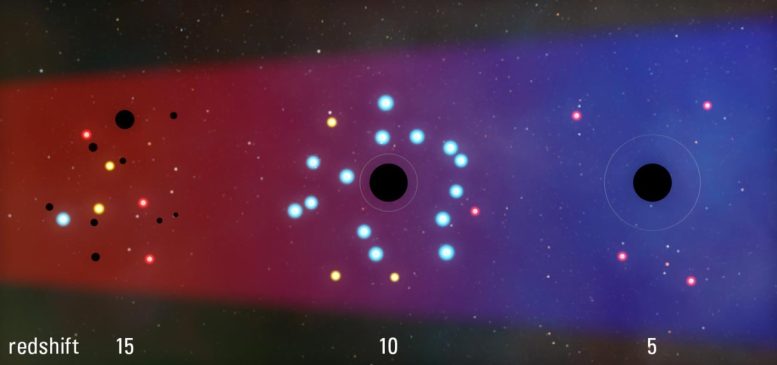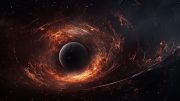
The transition in star formation rates and black hole growth as redshift decreases from regimes where positive feedback dominates to a later epoch when feedback is largely negative. Credit
Steven Burrows, Rosemary Wyse, and Mitch Begelman
The James Webb Space Telescope’s discovery of early galaxies with massive black holes challenges traditional galaxy formation theories, proposing a synchronous development of black holes and stars, a finding that could reshape our understanding of cosmic evolution.
Astronomers have long sought to understand the early universe, and thanks to the James Webb Space Telescope (JWST), a critical piece of the puzzle has emerged. The telescope’s infrared detecting “eyes” have spotted an array of small, red dots, identified as some of the earliest galaxies formed in the universe.
This surprising discovery is not just a visual marvel, it’s a clue that could unlock the secrets of how galaxies and their enigmatic black holes began their cosmic journey.
“The astonishing discovery from James Webb is that not only does the universe have these very compact and infrared bright objects, but they’re probably regions where huge black holes already exist,” explains JILA Fellow and University of Colorado Boulder astrophysics professor Mitch Begelman. “That was thought to be impossible.”
Begelman and a team of other astronomers, including Joe Silk, a professor of astronomy at Johns Hopkins University, published their findings in The Astrophysical Journal Letters, suggesting that new theories of galactic creation are needed to explain the existence of these huge black holes.
“Something new is needed to reconcile the theory of galaxy formation with the new data,” elaborates Silk, the lead author of the potentially groundbreaking study.
The Traditional Tale of Galaxy Formation
Astronomers had previously posited a somewhat orderly evolution when thinking about how galaxies formed. Conventional theories held that galaxies form gradually, assembling over billions of years. In this slow cosmic evolution, stars were thought to emerge first, lighting up the primordial darkness.
“The idea was that you went from this early generation of stars to the galaxies really becoming mainly dominated by stars,” adds Begelman. “Then, towards the end of this process, you start building these black holes.”
Supermassive black holes, those enigmatic and powerful entities, were believed to appear after the first stars, growing quietly in the galactic core. They were seen as regulators, occasionally bursting into action to temper the formation of new stars, thereby maintaining a galactic balance.
Challenging Conventional Wisdom
Thanks to the observations of the “little red dots” by the JWST, the researchers found that the first galaxies in the universe were brighter than expected, as many showed stars coexisting with central black holes known as quasars.
“Quasars are the most luminous objects in the universe,” explains Silk. “They are the products of gas accretion onto massive black holes in galaxy nuclei that generate immense luminosities, outshining their host galaxies. They are like monsters in the cuckoo’s nest.”
Seeing the coexistence of stars with black holes, the researchers quickly realized that the conventional theories of galaxy formation had to be flawed. “[This new data] looks like [the process is] reversed, that these black holes formed along with the first stars, and then the rest of the galaxy followed,” says Begelman. “We’re saying that the growth of the black hole, at first, promotes the stars. And only later, when conditions change, does it flip into a mode of turning off the stars.”
From this proposed new process, the researchers found that the relationship between star formation and black hole formation seemed closer than expected, as each initially amplified the growth of the other via a process known as positive feedback.
“Star formation accelerates massive black hole formation, and vice versa, in an inextricably connected interplay of violence, birth, and death that is the new beacon of galaxy formation,” says Silk.
Then, after almost a billion years, the nurturing giants became suppressive, depleting the gas reservoirs in their galaxies and quenching star formation. This “negative feedback” was due to energy-conserving outflows—powerful winds that drove gas out of the galaxies, starving them of the material needed to create new stars.
A New Galactic Timeline
Armed with the revelation of the black holes’ nurturing behavior, the researchers proposed a new timeline for the shift from positive to negative feedback in early galaxy formation. By looking at the different light spectra and chemical signatures emitted from these “little red dots,” the researchers suggested that this shift occurred around 13 billion years ago, one billion years after the Big Bang, a period astronomers classify as “z ≈6.”
Identifying this transition epoch helps astronomers target specific periods in the universe’s history for observation. It can guide future observational strategies using telescopes like JWST and others to study the early universe more effectively. Additionally, by understanding when this shift occurred, astronomers can better contextualize the characteristics of modern galaxies, including size, shape, star composition, and activity level.
Validating A Novel Process
To validate this new theory of collaborative galactic formation between the stars and black holes, and provide further insight into the processes involved, computer simulations are needed.
“This will take some time,” Begelman says. “The current computer simulations are rather primitive, and you need high resolution to understand everything. It takes a lot of computing power and is expensive.”
Until then, there are other steps the astronomy community can take to review and validate this new theory.
“The next steps will come from improved observations,” Silk adds. “The full power of JWST to study the spectra of the most distant galaxies will be unleashed over the next years.”
Both Begelman and Silk are optimistic about the rest of their field adopting their proposed idea.
“As far as I know, we’re the first to go in quite this extreme direction,” adds Begelman. “I was kind of pushing the envelope over the years with my collaborators working on this black hole formation problem. But JWST shows us that we didn’t think outside the box enough.”
For more on this research, see The Primordial Race Between Black Holes and Galaxies.
Reference: “Which Came First: Supermassive Black Holes or Galaxies? Insights from JWST” by Joseph Silk, Mitchell C. Begelman, Colin Norman, Adi Nusser and Rosemary F. G. Wyse, 30 January 2024, The Astrophysical Journal Letters.
DOI: 10.3847/2041-8213/ad1bf0









Advanced alien technology may be censoring what
earth’s primitive instruments are able to see.
The motivation would be alien. Earth may be an
alien entertainment streaming channel. It could be
scripted.
Simpler explanation is Universe is much older than currently scientific dogma allows. Luckily Universe does not know it, it is just older.
I think it’s more likely that these galaxies are a highly evolved end stage for galaxies. In which there remains nothing but a supermassive black hole and a remnant population of very old stars emitting mainly in the infrared, to be eventually gobbled up themselves. The mystery surrounding the origin of these and other highly evolved objects in the early universe therefore goes even deeper. And the ultimate fate of many of these bare supermassive black holes may be to eventually find their way into the centers of massive but less evolved star forming galaxies. Or conversely having star forming galaxies find and incorporate them. And merging with any black holes already existing there. The question would remain, how does a highly evolved galaxy with a supermassive black hole jibe with the heretofore expected conditions of the early universe. I would contend that it does not jive at all and that the Big Bang and posited Era of Cosmic Inflation narratives have a big problem aligning with observation.
These supermassive black holes were probably formed early on when the universe was full of hydrogen/ helium. It was so dense that when it cooled down enough to condense huge pockets collapsed creating these supermassive black holes. They were created 1st. Before anything else these supermassive black holes were created. The fact that these quasars that were monstrous yet so ancient even when I was in jr high school in the 90s I questioned how was it possible for these to exist if the red shift was accurate. It is very surprising the astrophysicists took over 30 yrs to figure out there was a problem with the theory of the big bang and how long it took and in what order things were created. I often wondered to myself how can these quasars exist so long ago with the theory being what it was. I am no astrophysicist tho. Just a normal person who has an intense interest in the universe. I’m glad things are becoming more clear of course but I often wonder if I had become an astrophysicist myself could i have been a voice of reason that could’ve sped up our understanding somewhat? Am I really this intelligent about seeing the inconsistencies of our theories or is it all just red tape and debunking the status quo takes much more than pesky little observations to create enough doubt needed to say wait a minute, this doesn’t add up! I was saying this in the 90s it’s only just catching on 30+ yrs later..hey nasa or the astrophysics community bring on more critical thinkers and less people who are willing to just tow the line..
Don’t be surprised if the conventional BBT adherents that are always lurking out there try to explain away all this observational evidence that doesn’t jibe with theory.